News from Haiti Vol. 5: Haiti’s Cultural Features (part 2)
Talking about Traditional Haitian Architecture and the Gingerbread Style
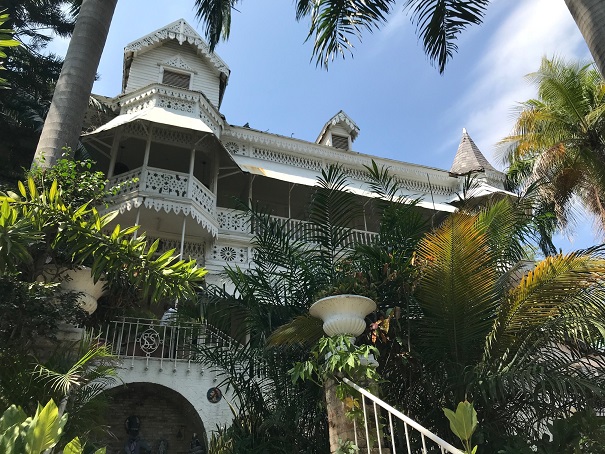
(Front view of the Oloffson Hotel in Port-au-Prince)
◆What is the Gingerbread Style?
In Haiti there is a specific architectural style called the Gingerbread Style. The style goes back over 100 years
or so, to the end of the 19th century, and buildings in this style were mainly houses of the upper class. There is a
growing need to preserve these historical buildings and designate them as national heritage sites.
(Characteristics) The Gingerbread Style is characterized by steep, pointed towers and gable roofs with wooden lattice work,
large columns in the front with a spacious veranda. Some buildings are made of only wood, others are stone, and some are a mixture,
and also mixture of concrete and wood.
In terms of functionality they are designed quite well, with high ceilings and even higher tower rooms that are meant to let the hot
air escape. All windows and doors are finished with wooden louvers (slotted panels instead of a single piece of wood) to not only block
the sunlight, but to let air flow through the building. The large verandas wrapping around the entrances of the buildings also serve to
protect the living rooms from the strong Haitian sunlight.
(Origins) The Gingerbread Style evolved in the 1860’s during Port-au-Prince’s trade and economic boom, where the upper class lifestyle was
at its peak. The center of Port-au-Prince had become too small, and so those with money moved out of the center of the city to the nearby to
hills and built houses in the current European fashion fused with local styles. After the destructive earthquake hit Haiti in 2010, the Haitian
FOKAL (Fondasyon Konesans Ak Libète) along with Columbia University, and the WMF (World Monument Fund) took a survey and drew up a list of the
remaining Gingerbread Style buildings and talked about their history in further detail.
In 1881 the second Presidential Palace was built, which is said to be the origin of the Gingerbread Style and is one of the models of this architecture.
At around the same time, another example of this architecture was built called the Villa Sam, which is now the Hotel Oloffson.
Additionally, in 1895 three Haitian architects Georges Baussan, Léon Mathon, and Joseph-Eugène Maximillien visited France and learned about French popular
architecture and brought their knowledge and experience back with them to Haiti where they created their own unique style. It was also at this time that
information about cheaper and more rational decorative methods started to appear, and the Gingerbread Style spread beyond the upper class.
Unfortunately the Presidential Palace was destroyed and the lives of the 21st president Cincinnatus Leconte and others were taken when a powder keg in
the basement of the palace exploded on August 8th, 1912. The palace was rebuilt with a new design without leaving any remnants of the previous building
behind.
(Whereabouts) Gingerbread style buildings are located mainly in the capital city Port-au-Prince, in particular the Bois Verna, Turgeau, Pacot, Deprez,
and Bas Peu de Choses areas. Some buildings are a victim of damage caused by ageing and the 2010 earthquake, and have not been fixed, whereas other
buildings survived the earthquake and have been beautifully restored. The Gingerbread Style is noted for its architectural features which help the
buildings survive Haiti’s natural disasters.
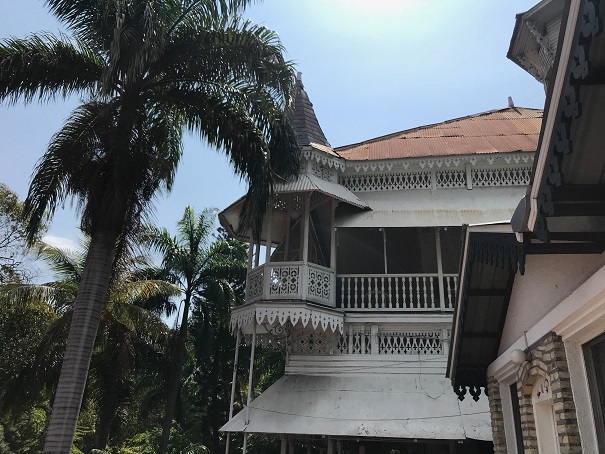
(The Oloffson Hotel in Port-au-Prince)
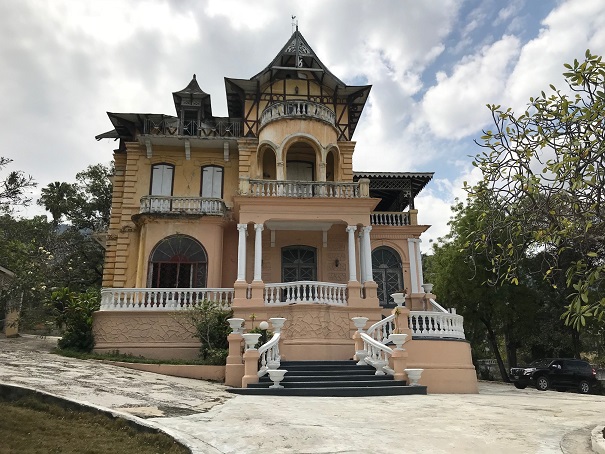
(Villa Miramar in Port-au-Prince)
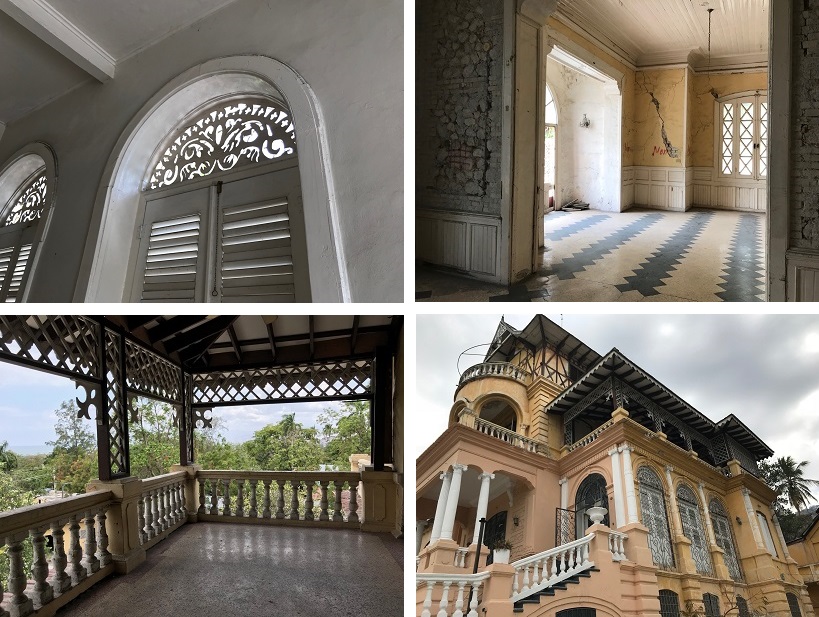
(Up-close at the Villa Miramar)
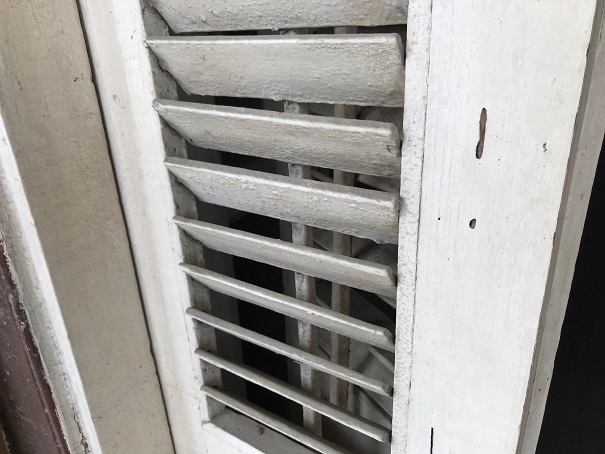
(Wooden louvers on the door at Villa Miramar)
There are many commonalities between the Gingerbread Style and others, but none can beat this school of architecture.
For example, regarding the design of the veranda, the design of large pillars giving the entrance a certain depth can be found in other Colonial architecture; however, compared to Haitian Gingerbread style, Colonial style pillars are much plainer than and not as decorative as the Haitian style.
Pointed roofs and decorative surfaces are a couple of the many characteristics Gingerbread buildings share with Victorian-era design. The similarities with the decorative surfaces are not always the determining architectural factor when comparing the styles, but both styles came about in the same time period. To be specific, the Victorian architectural style is a hodge-podge of previous architectural trends, bringing back certain elements (eclectic architecture), so it is natural to say that both the Gingerbread style and the Victorian style have similar influences given by those eclectic elements.
The English Victorian style spread over the sea to France, mainland Europe, then expanded over the ocean to the United States where it integrated with the existing styles and became the basis of a new style of architecture. The Haitian Gingerbread style is a testimony to how Haitian architects took into account design styles from oceans away and combined them with Haiti’s weather conditions to make a unique architectural design.
◆What is “Gingerbread”?
How come the French-Creole speaking nation of Haiti calls its architectural style by the English word “Gingerbread”? I did some research into the origin of the naming of this architectural style.
Before I go into details, I want to talk about the fretsaw, or jigsaw. Maybe some of you have used this before at home or at school. In French the name is “Scie à Chantouner”, as well as “Scie à ruban”. Its history runs from as far back as the 15th century, but during the 19th century it spread from France to England and other parts of Europe, and in the 1860’s America turned it into a foot-operated tool, and then in the early 1900’s it became a power tool. These improvements made it easier to use and better at wood openwork, and thus the fretsaw grew in popularity and use in French and European-influenced American Lambrequin openwork. Specifically, European Gothic architectural elements and motifs were replicated and mass-produced using woodwork and carpentry techniques, and incorporated into the building’s design. Original European Gothic architectural ornamentation was carved out of stone and difficult to complete. However, with the use of the jigsaw wood carving became easier and ornamentation on gable end roofs, under the eaves, on railings, arches, etc. became part of the design. At this time in America, the aforementioned Lambrequin woodwork was called “Gingerbread Trim” and the decoration was quite popular in ordinary homes. This is one part of the American Victorian style, and an element and characteristic of Haitian Gingerbread architecture.
When Americans tourists came to visit Haiti in the 1950’s and saw these familiar “gingerbread trim” designs, they started calling the buildings “gingerbread houses”, leading to the nickname “Gingerbread Style”.
Now that we know the openwork trim is called “gingerbread trim”, let’s talk about why it is called that. In order to do so, we need to look deep into European traditions, specifically gingerbread cake. Taking the gingerbread cake and turning it into a house and then decorating it was originally a German tradition which spread throughout Europe and over to America. The Grimm Brother’s fairy tale “Hansel and Gretel” helped popularize the image of the gingerbread house and the openwork wood carvings of the Victorian architectural design, which eventually came to be called “Gingerbread trim”.
During the previous presidential election, the United Nations Development Programme (UNDP) helped support the CEP by giving technical help and training to those involved in the election. Additionally the United Nations Stabilization Mission in Haiti (MINUSTAH) provided security escorts for the distribution and collection of ballots, seemingly to successfully wrap up the election. Due to the UN’s programs, Haiti was able to proceed with and end an election that some might claim was fraught with corruption, but by having a neutral body oversee the election any doubts should be cleared.
◆The relationship between Haitian and Japanese architecture
When the Gingerbread Style was popular in Haiti it was the Meiji period in Japan (1868-1912), and Western-style architecture was quite popular. It seems a little irrelevant to compare Japanese architecture with the Gingerbread style in Haiti, but while most of the Western-style buildings in Japan from that era were influenced by British architecture, one of these is the former home of the nobleman Tsugumichi Saigo, whose home in Meguro, Tokyo, was designed by a French architect is interesting. (from a personal view) What struck me about this house was the balcony design and its similarities to the Lambrequin openwork wood design which might be of same ancestor.
Another building of a former diplomat Sadatsuchi Uchida in the Yokohama Yamate Bluff district was an American Victorian designed home by the American architect James McDonald Gardiner in 1910. Although the exterior is quite simple, the elegance of the openwork and overall design calls to mind the Gingerbread Style of Haiti.
◆Deterioration
In spite of the architectural style established and integrated national and international elements in both function and design, in 1925, the mayor of Port-au-Prince issued an ordinance to stop the construction of wooden buildings in hopes of fire-prevention. This stopped the construction of new Gingerbread Style buildings in wooden carpentry, and most of new construction were moved on to concrete structure. This ordinance left the fate of the Gingerbread style to the remaining buildings, and severely cut back the number of such style buildings.
The longevity of wooden buildings increases if you put constant work into them, but this is not always feasible with limited income. When the major earthquake struck Haiti in 2010 destroying numerous buildings, many of the Gingerbread Style houses were left abandoned and unrepaired, and many were torn down to better use the land.
Regarding the practicality of maintaining these buildings, even though the family who initially built the home may have been of the bourgeoisie, there were cases where their children had difficulty taking care of the buildings after the parents had passed away. The tendency of big family adding the complexity to the heritage issues. Thus the peak of the Gingerbread Style architecture was from around 1860 to 1925. There are cases of buildings after 1925 which incorporated Gingerbread Style-like elements, but it is difficult to find any new buildings built completely in this style.
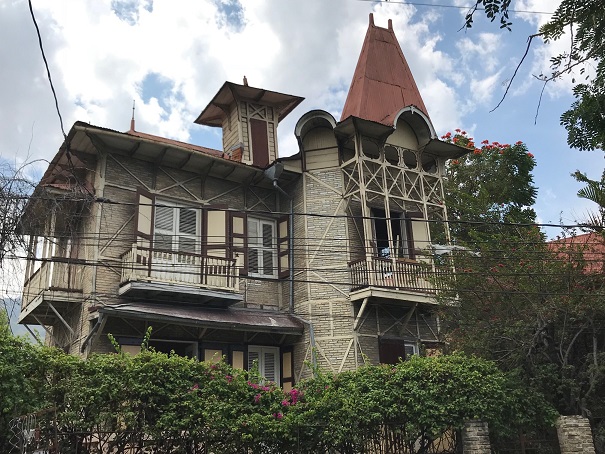
(Private residence of former President Tancrède Auguste in Port-au-Prince)
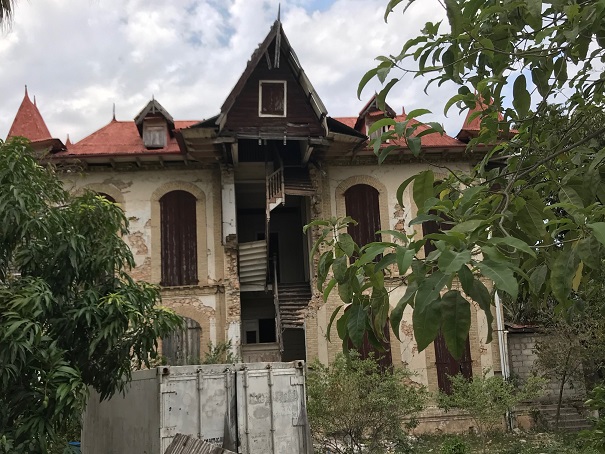
(Villa Castel Fleuri almost in ruins in Port-au-Prince was once used as the Presidential Palace)
Gingerbread architecture lays mainly in the capital city, Port-au-Prince, but there are examples of this style in neighboring Léogâne, Jérémie, Les Cayes, Cap-Haïtien, and Jacmel. However, buildings were built in some kind of architecture which having taste of Colonial Style but hard to say if it is the Gingerbread Style.
Take for instance the architecture in Jacmel, south-east Haiti. Some people call the architectural style “Gingerbread”, but actually it is closer to the Creole Townhouse style (1790-1850) as seen in the New Orleans French Quarter. The Hotel Florita, built in 1888, is a typical example of this type of architecture. The openwork on the balcony that projects out over the sidewalk differs from the Gingerbread Style, as well as using cast iron instead of wood for the pillars and ornamentation, using Spanish elements, drawing a line between the Gingerbread Style in terms of time period and style. For your reference, in 2012 Jacmel’s Historical District was put on the World Monuments Watch list by the WMF (World Monuments Fund), apart from the Port-au-Prince’s Gingerbread Style architecture.
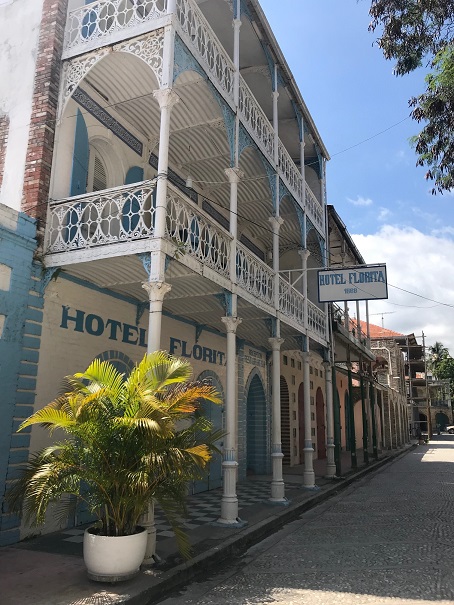
(Architecture of the Hotel Florita in Jacmel, south eastern Haiti)
Most of the Gingerbread Style buildings introduced in this column are over 100 years old and are ageing and are severely in need of repairs after being battered by hurricanes and rocked by earthquakes. If these beautiful pieces of architecture are left to be without care, their numbers will surely decrease.
To add to hurdles facing preservation, not all owners of these buildings have the financial means to upkeep and restore the houses, and the government still has not designated the buildings as an important cultural heritage. Thus the buildings rely on the good conscious and efforts of others to maintain them. Furthermore, with all the socio-economic problems piling up, and from some restraints to cover, it is hard to say that the best solution for the Gingerbread Style homes is to make them publicly-owned or not.
Recently, domestic and international attention has increased regarding the preservation of these historical buildings, and so I believe that focus will be placed on heightening awareness of the owners, and adding value to preservation efforts.
FOKAL is a Haitian cultural association group which has been leading the restoration and preservation efforts from early on. FOKAL is also engaged in activities related to promoting the historical significance and the importance of preservation; in 2010 they teamed up with ISPAN (Institut de Sauvegarde du Patrimoine National) and WMF to further specify the location of the remaining Gingerbread architecture, and to carry out surveys on the current condition of such buildings in order to keep a record of condition, location, specifications, etc.
In renovating the Maison Dufort, FOKAL held a training program in the shape of a workshop to help teach architectural techniques such as woodwork, material, and processing skills used before concrete took over the scene. The program ended in 2016, and currently a new one is underway.
I had a chance to talk with the President of FOKAL, Michele D. Pierre-Louis (she was formerly the Prime Minister of Haiti), the Executive Director Lorraine Mangones, and Farah F. Hyppolite, the person in charge of the architecture program. During our meeting they gave their idea of the future of the Gingerbread historical district, with renovations done to give the area a sense of unity, with cafes and boutiques around the area to make it into a walkable historical area.
I really admire and appreciate great works done by FOCAL and many others who are concerned and taking action for the future of the Gingerbread houses, and hoping that this nice and typical architecture to be maintained and developed integrally with development of Haiti.
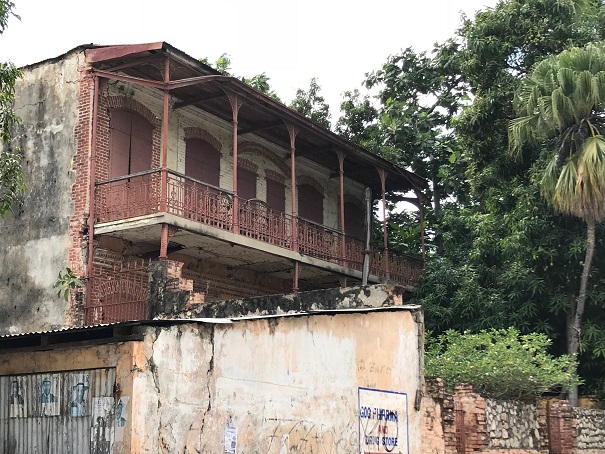
(Abandoned building in Jacmel after the 2010 earthquake)
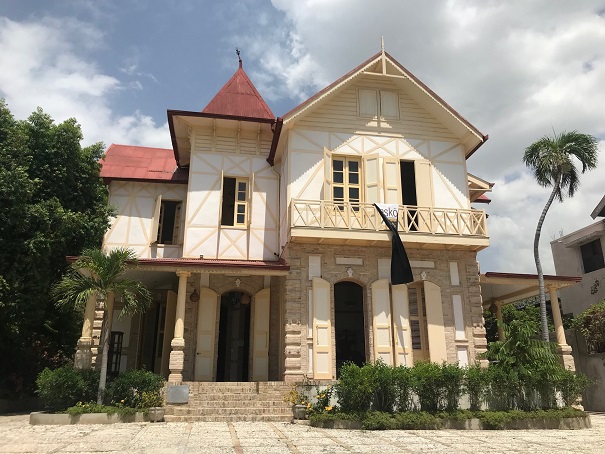
(Maison Dufort after renovations in Port-au-Prince)
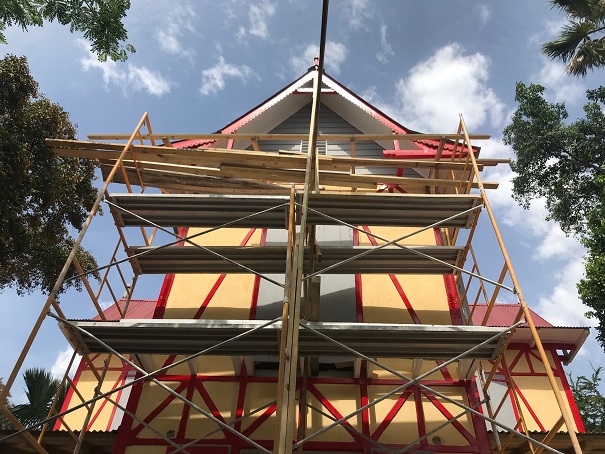
(A Gingerbread Style house under renovation by the Haitian group FOKAL)
(*This column reflects the personal views of the author and not the opinions of their employer)
Back numbers are here
WHAT'S NEW
- 2024.12.4 UPDATE
PROJECTS
"Barbados A Walk Through History Part 14"
- 2024.9.17 UPDATE
PROJECTS
"Barbados A Walk Through History Part 13"
- 2024.7.30 UPDATE
EVENTS
"408th Lecture Meeting Regarding Global Issues"
- 2024.7.23 UPDATE
PROJECTS
"Barbados A Walk Through History Part 12"
- 2024.7.9 UPDATE
ABOUT
"GREETINGS FROM THE PRESIDENT JULY 2024"
- 2024.7.4 UPDATE
EVENTS
"APIC Supports 2024 Japanese Speech Contest in Jamaica"
- 2024.6.27 UPDATE
EVENTS
"407th Lecture Meeting Regarding Global Issues"
- 2024.5.21 UPDATE
EVENTS
"406th Lecture Meeting Regarding Global Issues"
- 2024.5.14 UPDATE
EVENTS
"405th Lecture Meeting Regarding Global Issues"
- 2024.4.2 UPDATE
PROJECTS
"Water Tanks Donated to Island of Wonei, Chuuk, FSM"




